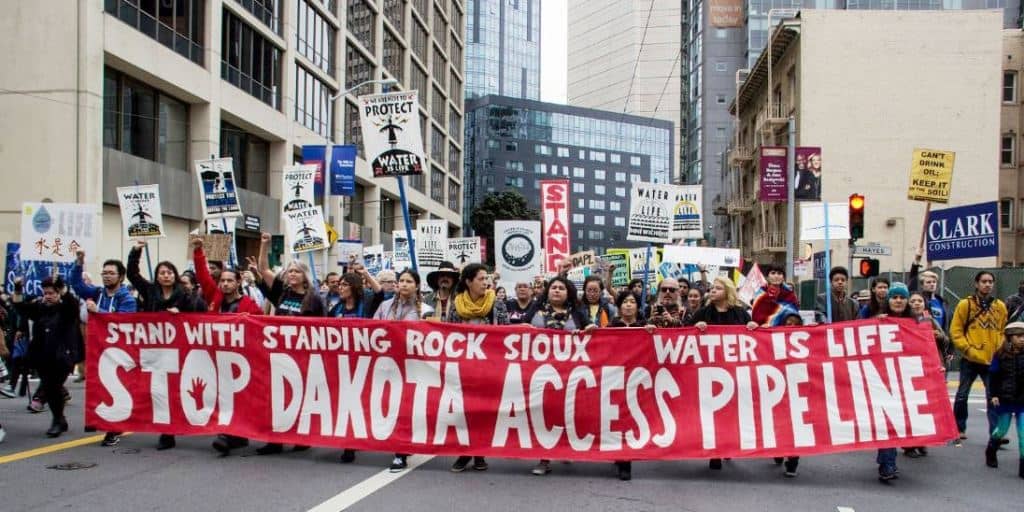[dropcap]H[/dropcap]aving the land you live on being taken from you, you think would be enough, but no. The Native Americans are dealing with another fight for their land in the 21 century. Keeping food and water resources clean, usable, and not contaminated with crude oil is important. This fight against the Dakota Access Pipeline (DAP) should not even be a thing in this day and age. The Native Americans should have a say in their land. the water and food sources they use, but they did not now, to start anyways. The government had originally approved the Dakota Access Pipeline without talking to Native Americans. Their concerns with it are that it will be running less than a mile from their reservations and under the Missouri River. This is a major issue if the pipeline were to leak into surrounding areas
The Standing Rock Sioux
The Standing Rock Sioux Reservation originated on April 29, 1868. The lands that the tribe lives on have been changed and greatly reduced throughout the centuries by the U.S. government. According to The Standing Rock Sioux Tribe, there are multiple Tribes living on the reservations in North and South Dakota and the National Environmental Policy Act of 1970 was their hope for slowing down/stopping the process of the DAP. This policy act gave the Tribes their voice in decisions concerning their land and resources around them that they use for survival. The Tribes only source of clean drinking water is from Lake Oahe, which is part of what is at stake if the DAP gets built. The DAP also runs underneath the Missouri River near the reservation and along the edge of the lake and the Tribes are worried about the pipeline leaking and contaminating the river and water sources nearby. The Tribes did not have a say in this building of the DAP to start because it is .55 miles from the reservation, not on the reservation.
$3.7 Billon DAP

StrategicWebDesign_Net / Pixabay
The Dakota Access Pipeline (DAP) is a 1,200-mile long pipeline from North Dakota to a terminal in Illinois and the BBC says it costs nearly $3.7 billion and is estimated to carry 470,000 barrels of crude oil daily across the four Midwest states. The DAP plan was created by the Texas Company Energy Transfer Partners to make transferring the crude oil easier and to increase profits for the oil companies. The Dakota Access Pipeline has sprung 3 leaks while still being built and this only made the case better for the Tribes and groups of people protesting it. The Texas company says their pipeline exceeds the minimum government safety standards and is
“monitored 24/7 by a control center for pressure, temperature, density and flow changes; has strategically placed valves with emergency shutdown systems; and is inspected in multiple ways throughout the year,” said a spokeswoman for the company.
Another problem was the Standing Rock Sioux Reservation and their only source for clean water, Lake Oahe, are in the way of the pipeline. The pipeline was still awaiting federal approval to use the land on/near the reservation.
First Protests
Within the first five days of being in office, President Trump signed orders for the pipeline project, originally halted by President Obama, to be approved as quickly as possible. According to Robinson Meyer for the Atlantic, hundreds then gathered outside the White House that night to protest President Trump’s decision. Protest by the Standing Rock Sioux Tribe and their supporters protested that the project would contaminate drinking water and damage sacred burial sites along the projected area. The Tribe and their supporters then set up multiple spiritual camps near the Missouri River. The protesters consisted of about 10,000 people and 200 plus Native American Tribes who pledge their support along with many others. Protests were not always peaceful; there were fires, riots, and aggressive force used by police and protesters.
Coming Together
These protests were not short lived and lasted for months through the harsh winter of North Dakota but yet people still came and stayed. These protests were a rare high profile fight for the Native Americans in part because they had activist for climate change on their side supporting them against the government’s decisions. The two groups came together for the same goal but for different reasons: climate activists saw it as new fossil fuel infrastructure which we are trying to get rid of, and the Native Americans saw it as another profit making incision on their land.
From 280 Tribes, a
Protest on the Plains https://t.co/MbaOhZk3dQ #NoDAPL @POTUS #INDIGENOUS #TAIRP pic.twitter.com/qrl7L9ZOEf— Indigenous (@AmericanIndian8) September 12, 2016
Halting Progress
The Army Corps of Engineers decided to halt construction until a further review could be done to ensure the pipeline was safe to be built. Also in a press release from September 2016 from the United States Department of Justice states that
“Therefore, this fall, we will invite tribes to formal, government-to-government consultations on two questions: (1) within the existing statutory framework, what should the federal government do to better ensure meaningful tribal input into infrastructure-related reviews and decisions and the protection of tribal lands, resources, and treaty rights; and (2) should new legislation be proposed to Congress to alter that statutory framework and promote those goals.”
This decision is a victory for Tribes because it gives them a voice where they have not had a voice before.
Granting Progress
Although after months of consideration, in February 2017 the Army Corps of Engineers stated it would grant the final easement for the last section of the Dakota Access Pipeline along the edge of the reservation. Robinson Meyer at The Atlantic says the Tribe had another victory this past June when judge Boasberg from the D.C. District Court stated that the U.S. Army Corps of Engineers had failed to perform a study of the environment around Lake Oahe that met the standards of the Judge. It was missing important information from the study results. Like stated earlier, President Trump signed the continuation of building the pipeline within 5 days of entering office and, considering the following statement, he was not thinking.
“I just closed my eyes and said: ‘Do it,’” President Trump said of approving the pipeline this week.

anita_starzycka / Pixabay
The Effects
The Dakota Access Pipeline began moving oil from North Dakota to Illinois on June 1, 2017, underneath Lake Oahe, which is the crucial water supply for the Lakota and Dakota Tribes. The Tribes are still fighting their battles in court and have recently got a ruling their way. According to the New York Times, the Texas-based builder of the pipeline has fines to pay and 100,000 trees to plant because of state rules that they violated while building the pipeline. This is still not what protesters wanted at all to happen, but this is what has been happening to Native Americans their entire lives since the Europeans started coming over, taking their land, and not giving them much of a say in anything that happens.
Featured image by Native American Calling





What do you think?
Show comments / Leave a comment